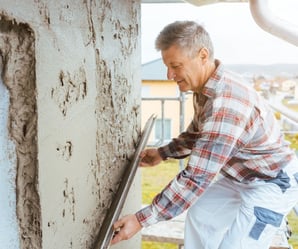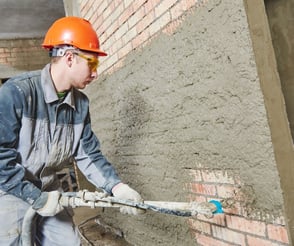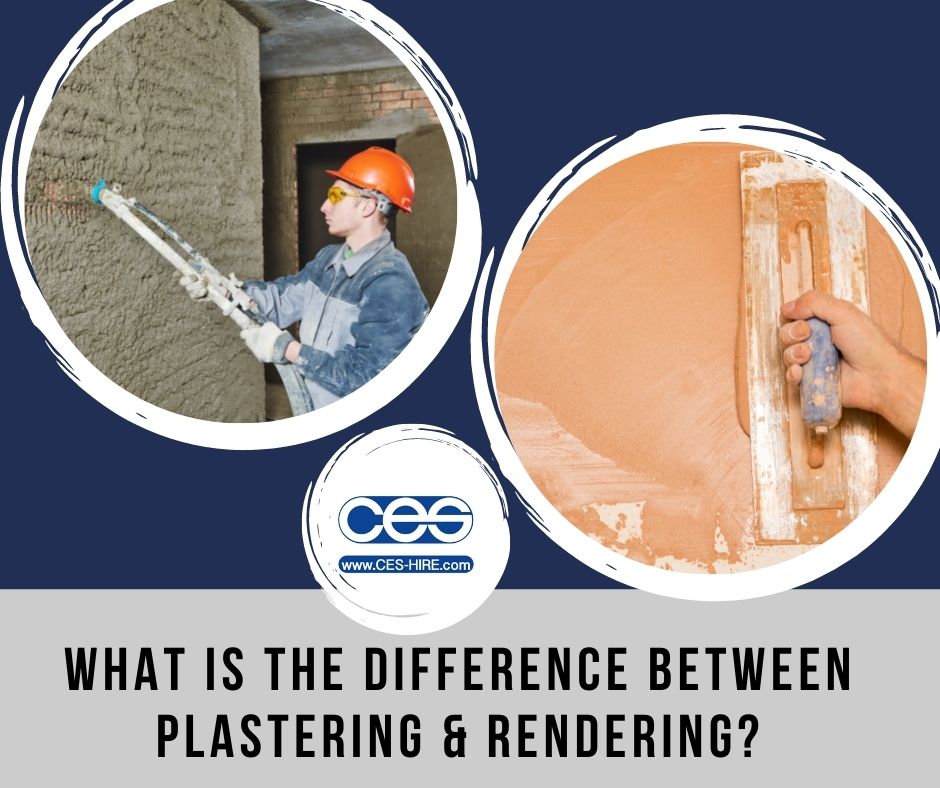Plaster or Render?
If you’re in the trade, the answer to this question may seem obvious but to your client this is a very normal and common question. So, without being Patronising Paul, how do you explain the difference between plastering and rendering to Simple Sally? (Pauls and Sallys…please do not take offence to our generic reference!)

The Cover Story
Plastering and rendering is essentially both covering a wall or surface. Both processes also require a similar material made up of cement, sand, water and lime gypsum. Either can be applied using hand methods using hawk and trowel techniques or using a machine such as those supplied by CES. This is where the similarities end. Fundamentally render is used to coat exterior surfaces and plastering is the process of covering interior walls and ceilings. Due to these slightly different purposes, render is made up of a heavier composition to create a coarser more durable external finish where as plaster is mixed with a finer sand to ensure a smoother appearance suited to internal decorative finishes.
Weather the Storm
The main reason for a coarser finish when it comes to render is the weather. We live in the UK, so a good weather chat is high on our agenda! Render acts as a protective barrier to brick and blockwork which is ideal in harsh climates (it seems these days that’s most of the UK) particularly coastal or exposed hilly areas. To achieve a rougher composition a higher percentage of sand is added to the render. This heavier cement base suits the exterior purpose making it weatherproof (wind, rain sun proof) and fireproof. Additional polymers are added to many renders to increase water resistance and strength further as well as prevent cracking. As well as the functional element of render preserving brickwork, often it is applied entirely to enhance the visual appeal of the house. It is one of the easiest ways to transform your homes appearance. Whilst the lime gypsum is key in giving the coating it’s creamy colouring and smooth finish, you can also add other coloured pigment to the material which then saves on subsequent painting costs.
In a nutshell, these are the main reasons for rendering your home:
-Enhancing your homes appearance and perhaps hide brickwork/features that are not to your taste
-Changing the colour of your home
-Repairing cracks and damage
-Increasing the value of your property
-Adding insulation
-Adding waterproofing/fireproofing
-Reducing long-term maintenance costs (render will protect your home for years)
-Avoiding more costly and time-consuming brickwork detail on a new build home (render simply covers blockwork)
-Options for a variety of finishes-smooth, flat, textured or patterned (including ashlar cut designs)

Let’s Get Plastered
Plaster is a more commonly known term being seen as a traditional craft. Coating interior walls and ceilings in plaster dates back thousands of years. Ever been to the Ancient Egyptian pyramids? Well, you’ll see plastering going on, even back then (total plastering-geek moment right there)! Plastering creates a smooth surface so paint or wallpaper is easy to apply. Plaster contains less cement and finer sand to achieve this light and smooth finish. This process has more of a decorative function because it does not need the weather resistant properties of render. Since plaster is not exposed to wind, rain and sun, it does not need the same strength in its composition as render does. Whilst it is not a weatherproof coating, plaster is water repellent and easy to clean which is perfect for family living and greasy/food-smeared fingerprints that typically end up on your walls! It is important to remember that plaster will take between one week to one month to fully dry and be ready for a decorative finish. You’ll know it’s dry once any dark patches have disappeared and the entire surface is a consistently light colour. FYI, drying out plaster too quickly can lead to cracking so speeding up the process is not advised.

Plastering & Rendering at CES
So, there you have it, you’re now a complete expert on the difference between plaster and render. Don’t forget CES stock a wide range of rendering supplies, products and tools for preparation and application of both plaster and render. If you’re already converted to machine application of plaster and render, then check out our range of machines from small electric options to big diesel units. And if you’re new to the world of machine application, our machines are available to hire as well as try before you buy options. Browse our website or give us a call to find the best machine for you.



